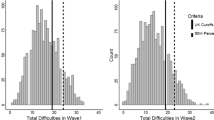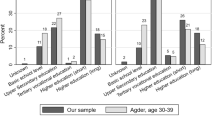Abstract
Background
Quality assessment of children’s functioning is critical for both research and service delivery. The Strengths and Difficulties Questionnaire (SDQ) is a brief, publicly-available instrument that provides such assessment. Although the SDQ has strong psychometric properties, less is known about its responsiveness or sensitivity to detecting change over time.
Objective
This study examined the responsiveness of the SDQ among high-risk youth and tested the degree to which changes on the SDQ correspond to changes on the Child Behavior Checklist (CBCL), a well-established and lengthier reference measure.
Methods
Longitudinal SDQ and CBCL data collected as part of routine service delivery were analyzed for 65 youth entering a large residential treatment program. Assessments were obtained both at intake and approximately 3 months into the program.
Results
Paired samples t tests revealed statistically significant decreases in SDQ Conduct Problems and Emotional Symptoms scores, and McNemar’s tests showed a statistically significant decrease in the proportion of Conduct Problems cases. Correlations between changes on the SDQ scales and changes on corresponding CBCL scales ranged from .58 to .83. Results from receiver operating characteristic curves indicated that the SDQ was relatively accurate in identifying changes in CBCL diagnostic cases, with overlap across corresponding problem behavior domains ranging from 68 to 81 %.
Conclusions
Findings suggest that the SDQ may represent a shorter, low cost alternative to longer measures, such as the CBCL, for use when researchers and practitioners are faced with time or financial constraints associated with the assessment of child functioning over time.
Similar content being viewed by others
References
Achenbach, T. M., & Rescorla, L. A. (2001). Manual for the ASEBA school-age forms and profiles. Burlington, VT: University of Vermont, Research Center for Children, Youth, & Families.
Altman, D., Vergouwe, Y., Royston, P., & Moons, K. (2009). Prognosis and prognostic research: Validating a prognostic model. British Medical Journal, 338, 1432–1435.
Bourdon, K. H., Goodman, R., Rae, D. S., Simpson, G., & Koretz, D. S. (2005). The Strengths and Difficulties Questionnaire: U.S. normative data and psychometric properties. Child and Adolescent Psychiatry, 44, 557–564.
Bradshaw, C. P., Brown, J. S., & Hamilton, S. F. (2008). Bridging positive youth development and mental health services for youth with serious behavior problems. Child & Youth Care Forum, 37, 209–226. doi:10.1007/s10566-008-9060-8.
Casey, K. J., Reid, R., Trout, A. L., Hurley, K. D., Chmelka, M. B., & Thompson, R. (2010). The transition status of youth departing residential care. Child & Youth Care Forum, 39, 323–340. doi:10.1007/s10566-010-9106-6.
Catalano, R. F., Berglund, M. L., Ryan, J. A. M., Lonczak, H. S., & Hawkins, J. D. (2004). Positive youth development in the United States: Research findings on evaluations of positive youth development programs. Annals of the American Academy of Political and Social Science, 591, 98–124. doi:10.1177/0002716203260102.
Cuthbert, R., Pierre, J. S., Stewart, S. L., Cook, S., Johnson, A. M., & Leschied, A. W. (2011). Symptom persistence in seriously emotionally disordered children: Findings of a two-year follow-up after residential treatment. Child & Youth Care Forum, 40, 267–280. doi:10.1007/s10566-010-9137-z.
Davis, J., & Daly, D. L. (2003). Girls and Boys Town long-term residential program: Training manual (4th ed.). Boys Town, NE: Father Flanagan’s Boys’ Home.
Derogatis, L. R. (1993). Brief Symptom Inventory (BSI): Administration, scoring, and procedures manual (4th ed.). Minneapolis, MN: National Computer Systems.
Elander, J., & Rutter, M. (1996). An update on the status of the Rutter parents’ and teachers’ scales. Child Psychology & Psychiatry Review, 1, 31–35.
Ferdinand, R. F., Verhulst, F. C., & Wiznitzer, M. (1995). Continuity and change of self-reported problem behaviors from adolescence into young adulthood. Journal of the American Academy of Child and Adolescent Psychiatry, 34, 680–690. doi:10.1097/00004583-199505000-00020.
Fixsen, D. L., Blase, K. A., Timbers, G. D., & Wolf, M. M. (2001). In search of program implementation: 792 replications of the teaching-family model. In G. A. Bernfeld, D. P. Farrington, & A. W. Leschied (Eds.), Offender rehabilitation in practice: Implementing and evaluating effective programs (pp. 149–166). London: Wiley.
Gage, J. C., Overpeck, M. D., Nansel, T. R., & Kogan, M. D. (2005). Peer activity in the evenings and participation in aggressive and problem behaviors. Journal of Adolescent Health, 37, 517.e7–517.e14.
Ginsburg, G. S., Becker, K. D., Drazdowski, T. K., & Tein, J. Y. (2012). Treating anxiety disorders in inner city schools: Results from a pilot randomized controlled trial comparing CBT and usual care. Child & Youth Care Forum, 41, 1–19. doi:10.1007/s10566-011-9156-4.
Ginsburg, G. S., Keeton, C., Drazdowski, T. K., & Riddle, M. A. (2011). The utility of clinicians ratings of anxiety using the Pediatric Anxiety Rating Scale (PARS). Child & Youth Care Forum, 40, 93–105. doi:10.1007/s10566-010-9125-3.
Goodman, A., Lamping, D. L., & Ploubidis, G. B. (2010). When to use broader internalising and externalising subscales instead of the hypothesised five subscales on the Strengths and Difficulties Questionnaire (SDQ): Data from British parents, teachers and children. Journal of Abnormal Child Psychology, 38, 1179–1191. doi:10.1007/s10802-010-9434-x.
Goodman, R. (1997). The Strengths and Difficulties Questionnaire: A research note. Journal of Child Psychology and Psychiatry, 38, 581–586.
Goodman, R. (1999). The extended version of the Strengths and Difficulties Questionnaire as a guide to child psychiatric caseness and consequent burden. Journal of Child Psychology and Psychiatry, 40, 791–799.
Goodman, R. (2001). Psychometric properties of the Strengths and Difficulties Questionnaire. Journal of the American Academy of Child and Adolescent Psychiatry, 40, 1337–1345.
Goodman, R., Ford, T., Simmons, H., Gatward, R., & Meltzer, H. (2000). Using the Strengths and Difficulties Questionnaire (SDQ) to screen for child psychiatric disorders in a community sample. British Journal of Psychiatry, 177, 534–539.
Goodman, R., Ford, T., Corbin, T., & Meltzer, H. (2004). Using the Strengths and Difficulties Questionnaire (SDQ) multi-informant algorithm to screen looked-after children for psychiatric disorders. European Child and Adolescent Psychiatry, 13(Suppl2), 25–31. doi:10.1007/s00787-004-2005-3.
Goodman, R., & Scott, S. (1999). Comparing the Strengths and Difficulties Questionnaire and the Child Behavior Checklist: Is small beautiful? Journal of Abnormal Child Psychology, 27, 17–24.
Hofstra, M. B., van der Ende, J., & Verhulst, F. C. (2000). Continuity and change of psychopathology from childhood into adulthood: A fourteen-year follow-up study. Journal of the American Academy of Child and Adolescent Psychiatry, 39, 850–858.
Holtmann, M., Buchmann, A. F., Esser, G., Schmidt, M. H., Banaschewski, T., & Laucht, M. (2011). The Child Behavior Checklist-dysregulation profile predicts substance use, suicidality, and functional impairment: A longitudinal analysis. Journal of Child Psychology and Psychiatry, 52, 139–147. doi:10.1111/j.1469-7610.2010.02309.x.
Husted, J. A., Cook, R. J., Farewell, V. T., & Gladman, D. D. (2000). Methods for assessing responsiveness: A critical review and recommendations. Journal of Clinical Epidemiology, 53, 459–468. doi:10.1016/S0895-4356(99)00206-1.
James, S. (2011). What works in group care?—A structured review of treatment models for group homes and residential care. Children and Youth Services Review, 33, 308–321. doi:10.1016/j.childyouth.2010.09.014.
Janssens, A., & Deboutte, D. (2009). Screening for psychopathology in child welfare: The Strengths and Difficulties Questionnaire (SDQ) compared with the Achenbach System of Empirically Based Assessment (ASEBA). European Child and Adolescent Psychiatry, 18, 691–700. doi:10.1007/s00787-009-0030-y.
Kaminski, J. W., Valle, L. A., Filene, J. H., & Boyle, C. L. (2008). A meta-analytic review of components associated with parent training program effectiveness. Journal of Abnormal Child Psychology, 36, 567–589. doi:10.1007/s10802-007-9201-9.
Kerig, P. K., Moeddel, M. A., & Becker, S. P. (2011). Assessing the sensitivity and specificity of the MAYSI-2 for detecting trauma among youth in juvenile detention. Child & Youth Care Forum, 40, 345–362. doi:10.1007/s10566-010-9124-4.
Klasen, H., Woerner, W., Wolke, D., Meyer, R., Overmeyer, S., Kaschnitz, W., et al. (2000). Comparing the German versions of the Strengths and Difficulties Questionnaire (SDQ-Deu) and the Child Behavior Checklist. European Child and Adolescent Psychiatry, 9, 271–276.
Larzelere, R. E., Daly, D. L., Davis, J. L., Chmelka, M. B., & Handwerk, M. L. (2004). Outcome evaluation of Girls and Boys Town’s family home program. Education & Treatment of Children, 27, 130–149.
Lee, B. R., & Thompson, R. W. (2008). Comparing outcomes for youth in treatment foster care and family-style group care. Children and Youth Services Review, 30, 746–757. doi:10.1016/j.childyouth.2007.12.002.
Lengua, L. J., Sadowski, C. A., Friedrich, W. N., & Fisher, J. (2001). Rationally and empirically derived dimensions of children’s symptomatology: Expert ratings and confirmatory factor analyses of the CBCL. Journal of Consulting and Clinical Psychology, 69, 683–698.
Lerner, R. M., Lerner, J. V., Almerigi, J. B., & Theokas, C. (2005). Positive youth development: Current research perspectives. Journal of Early Adolescence, 25, 10–16.
Luthar, S. S. (2006). Resilience in development: A synthesis of research across five decades. In D. Cicchetti & D. J. Cohen (Eds.), Developmental psychopathology, Vol 3: Risk, disorder, and adaptation (2nd ed., pp. 739–795). Hoboken, NJ: Wiley.
Mason, W. A., Kosterman, R., Hawkins, J. D., Herrenkohl, T. I., Lengua, L. J., & McCauley, E. (2004). Predicting depression, social phobia, and violence in early adulthood from childhood behavior problems. Child & Adolescent Psychiatry, 43, 307–315.
Mathai, J., Anderson, J., & Bourne, A. (2002). The Strengths and Difficulties Questionnaire (SDQ) as a screening measure prior to admission to a Child and Adolescent Mental Health Service (CAMHS). Australian e-Journal for the Advancement of Mental Health, 1(3), 235–246.
Muris, P., Meesters, C., Eijkelenboom, A., & Vincken, M. (2004). The self-report version of the Strengths and Difficulties Questionnaire: Its psychometric properties in 8- to 13-year-old non-clinical children. British Journal of Clinical Psychology, 43, 437–448. doi:10.1348/0144665042388982.
Petty, C. R., Rosenbaum, J. F., Hirshfeld-Becker, D. R., Henin, A., Hubley, S., LaCasse, S., et al. (2008). The child behavior checklist broad-band scales predict subsequent psychopathology: A 5-year follow-up. Journal of Anxiety Disorders, 22, 532–539. doi:10.1016/j.janxdis.2007.04.003.
Quay, H. C., & Peterson, D. R. (1993). The revised behavior problem checklist: Manual. Odessa, FL: Psychological Assessment Resources.
Ringle, J. L., Ingram, S. D., & Thompson, R. W. (2010). The association between length of stay in residential care and educational achievement: Results from 5- and 16-year follow-up studies. Children and Youth Services Review, 32, 974–980. doi:10.1016/j.childyouth.2010.03.022.
Stephenson, M. T., Hoyle, R. H., Palmgreen, P., & Slater, M. D. (2003). Brief measures of sensation seeking for screening and large-scale surveys. Drug and Alcohol Dependence, 72, 279–286. doi:10.1016/j.drugalcdep.2003.08.003.
Thompson, R. W., Smith, G. L., Osgood, D. W., Dowd, T. P., Friman, P. C., & Daly, D. L. (1996). Residential care: A study of short- and long-term educational effects. Children & Youth Services Review, 18, 221–242.
Ungar, M. (2005). Resilience among children in child welfare, corrections, mental health and educational settings: Recommendations for service. Child & Youth Care Forum, 34, 445–464.
Conflict of interest
The authors declare that they have no conflicts of interests.
Author information
Authors and Affiliations
Corresponding author
Rights and permissions
About this article
Cite this article
Mason, W.A., Chmelka, M.B. & Thompson, R.W. Responsiveness of the Strengths and Difficulties Questionnaire (SDQ) in a Sample of High-Risk Youth in Residential Treatment. Child Youth Care Forum 41, 479–492 (2012). https://doi.org/10.1007/s10566-012-9179-5
Published:
Issue Date:
DOI: https://doi.org/10.1007/s10566-012-9179-5




